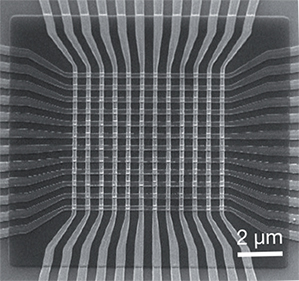A Better Way to Build Brain-Inspired Chips
Memristors, exotic electronic devices only confirmed to exist in 2008, have been used to create a chip that borrows design points from the brain. The prototype chip did not learn to do anything more difficult than recognize extremely simple black-and-white patterns. But larger, more complex versions might make computers better at understanding speech, images, and the world around them.

The circuitry of the chip, built by researchers at the University of California, Santa Barbara, and Stony Brook University, processes data not with digital logic circuits but with elements that mimic, in simplified form, the neurons and synapses of biological brains. When a network like that is exposed to new data, it “learns” as the synapses that connect neurons adjust the neurons’ influence on one another.
Software versions of artificial neural networks have been around for a long time, and large ones have recently produced breakthroughs in speech and facial recognition from companies such as Google and Facebook (see “10 Breakthrough Technologies 2013: Deep Learning”). But such simulated neural networks tax conventional computers. A Google experiment in which a large neural network learned to recognize cats from YouTube images ran on 16,000 processors over three days. Physically building a neural network on a chip instead could make this type of information processing much more power-efficient and practical. Such chips might allow mobile robots, for example, to become much smarter.
Brain-inspired—or “neuromorphic”—chips have been made before, and IBM is trying to commercialize them (see “Thinking in Silicon”). They generally use the same silicon transistors and digital circuits that make up ordinary computer processors. But those digital components are not suited to mimicking synapses, says Dmitri Strukov, an assistant professor at the University of California, Santa Barbara, who led work on the new memristor chip. Many transistors and digital circuits are needed to represent a single synapse. By contrast, each of the 100 or so synapses on the UCSB chip is represented using only a single memristor.
“A [biological] synapse is an analog memory device, and there is really no good way of implementing that in a compact, energy-efficient way with conventional technology,” says Strukov. “Memristors by themselves are an analog memory device; it’s a perfect match.”
The new chip is described today in a paper in the journal Nature. In a related commentary on the work, Robert Legenstein, an associate professor at Graz University of Technology in Austria, wrote: “If this design can be scaled up to large network sizes, it will affect the future of computing … Laptops, mobile phones and robots could include ultra-low-power neuromorphic chips that process visual, auditory and other types of sensory information.”
The memristor was mathematically predicted in 1971 by Leon Chua, a professor of electronics at the University of California, Berkeley. It was declared “found” in 2008, when researchers at Hewlett-Packard, including Strukov, made simple devices whose electrical resistance encoded a kind of memory of the current they had experienced before—just the property Chua had predicted (see “HP Rewires Electronics”). The devices were immediately seen as having the potential to be used for denser data storage and to make hardware neural networks.
HP and memory manufacturer SK Hynix started trying to commercialize memristor data storage in 2010; HP is betting the technology will make it possible to radically redefine the basic architecture of computers (see “Machine Dreams”). But until now, no one had created a neural-network chip built just with memristors, says Strukov. His group developed ways to control the process of making memristors so as to produce more reliable devices than had been made before, he says.
The UCSB group’s simple chip is just a proof of concept, but the researchers believe their techniques can be scaled up to make larger, more powerful devices. Strukov says the technology could get a helping hand from the efforts companies such as HP and SK Hynix are making to commercialize memristors for data storage.
Keep Reading
Most Popular
Large language models can do jaw-dropping things. But nobody knows exactly why.
And that's a problem. Figuring it out is one of the biggest scientific puzzles of our time and a crucial step towards controlling more powerful future models.
How scientists traced a mysterious covid case back to six toilets
When wastewater surveillance turns into a hunt for a single infected individual, the ethics get tricky.
The problem with plug-in hybrids? Their drivers.
Plug-in hybrids are often sold as a transition to EVs, but new data from Europe shows we’re still underestimating the emissions they produce.
Stay connected
Get the latest updates from
MIT Technology Review
Discover special offers, top stories, upcoming events, and more.